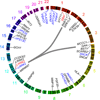The Evolution of Genetics: Alzheimer's and Parkinson's Diseases
- PMID: 27311081
- PMCID: PMC4936485
- DOI: 10.1016/j.neuron.2016.05.040
The Evolution of Genetics: Alzheimer's and Parkinson's Diseases
Abstract
Genetic discoveries underlie the majority of the current thinking in neurodegenerative disease. This work has been driven by the significant gains made in identifying causal mutations; however, the translation of genetic causes of disease into pathobiological understanding remains a challenge. The application of a second generation of genetics methods allows the dissection of moderate and mild genetic risk factors for disease. This requires new thinking in two key areas: what constitutes proof of pathogenicity, and how do we translate these findings to biological understanding. Here we describe the progress and ongoing evolution in genetics. We describe a view that rejects the tradition that genetic proof has to be absolute before functional characterization and centers on a multi-dimensional approach integrating genetics, reference data, and functional work. We also argue that these challenges cannot be efficiently met by traditional hypothesis-driven methods but that high content system-wide efforts are required.
Keywords: Alzheimer’s disease; Exome sequencing; Genetics; Genome-wide association; Parkinson’s disease.
Published by Elsevier Inc.
Figures






References
-
- Bonifati V, Rizzu P, van Baren MJ, Schaap O, Breedveld GJ, Krieger E, Dekker MCJ, Squitieri F, Ibanez P, Joosse M, van Dongen JW, Vanacore N, van Swieten JC, Brice A, Meco G, van Duijn CM, Oostra BA, Heutink P. Mutations in the DJ-1 gene associated with autosomal recessive early-onset parkinsonism. Science. 2003;299:256–259. - PubMed
-
- Chartier-Harlin M-C, Dachsel JC, Vilariño-Güell C, Lincoln SJ, Leprêtre F, Hulihan MM, Kachergus J, Milnerwood AJ, Tapia L, Song M-S, Le Rhun E, Mutez E, Larvor L, Duflot A, Vanbesien-Mailliot C, Kreisler A, Ross OA, Nishioka K, Soto-Ortolaza AI, Cobb SA, Melrose HL, Behrouz B, Keeling BH, Bacon JA, Hentati E, Williams L, Yanagiya A, Sonenberg N, Lockhart PJ, Zubair AC, Uitti RJ, Aasly JO, Krygowska-Wajs A, Opala G, Wszolek ZK, Frigerio R, Maraganore DM, Gosal D, Lynch T, Hutchinson M, Bentivoglio AR, Valente EM, Nichols WC, Pankratz N, Foroud T, Gibson RA, Hentati F, Dickson DW, Destée A, Farrer MJ. Translation initiator EIF4G1 mutations in familial Parkinson disease. Am. J. Hum. Genet. 2011;89:398–406. - PMC - PubMed
-
- Claussnitzer M, Dankel SN, Kim K-H, Quon G, Meuleman W, Haugen C, Glunk V, Sousa IS, Beaudry JL, Puviindran V, Abdennur NA, Liu J, Svensson P-A, Hsu Y-H, Drucker DJ, Mellgren G, Hui C-C, Hauner H, Kellis M. FTO Obesity Variant Circuitry and Adipocyte Browning in Humans. N. Engl. J. Med. 2015;373:895–907. - PMC - PubMed
-
- Dickson D, Hardy J, Singleton A, Bras J, Guerreiro R, Escott-Price V, Darwent L, Parkkinen L, Ansorge O, Hernandez DG, Nalls MA, Clark L, Honig L, Marder K, van der Flier W, Holstege H, Louwersheimer E, Lemstra A, Scheltens P, Rogaeva E, St George-Hyslop P, Londos E, Zetterberg H, Ortega-Cubero S, Pastor P, Ferman TJ, Graff-Radford NR, Ross OA, Barber I, Braae A, Brown K, Morgan K, Maetzler W, Berg D, Troakes C, Al-Sarraj S, Lashley T, Compta Y, Revesz T, Lees A, Cairns NJ, Halliday GM, Mann D, Pickering-Brown S, Powell J, Lunnon K, Lupton MK International Parkinson’s Disease Genomics Consortium (IPDGC) Genome-wide analysis of genetic correlation in dementia with Lewy bodies, Parkinson’s and Alzheimer’s diseases. Neurobiol. Aging. 2015 - PMC - PubMed
Publication types
MeSH terms
Grants and funding
LinkOut - more resources
Full Text Sources
Other Literature Sources
Medical
Miscellaneous

